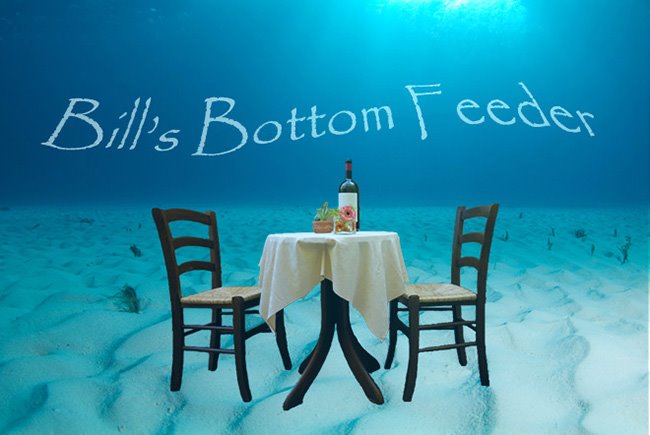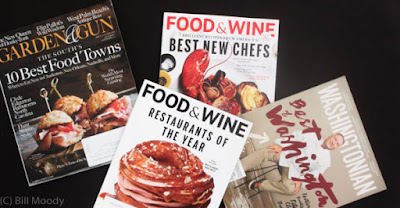Can't beat that!
I assume everybody has had enough rain by now! Our mighty Davis Vantage Pro 2 on the roof
says we have had 6.16 inches this month, and 26.1 for the year. Good for the crops?
Anyway, just two items (left off the third) of interest and a bonus
Magazines
As readers are (painfully) aware, especially MFO! I get tons of food
magazines. Over time, you learn there is
a common pattern to most of them.
Depending on the season of the year, there are always issues devoted to:
Grilling (summer & winter!)
foreign cuisines
of course seasonal issues
And of course a whole raft of “best” issues of restaurants,
chefs, etc., you name it
Extra credit, who’s the chef on the far right (can hardly
miss him these days)
And there are some I just skim
Plus there's always a "Cookie" issue, a "Cook like a chef" one, etc., But the one that irk me most, which always shows up at
some point during the year in the Regional rags like the Washingtonian, Baltimore, and St. Louis magazines. Is "Cheap Eats"
They begin their article with (non-italicized mine): “Peruse
restaurant menus these days, with their $32 Burritos and $24 Sandwiches (no source given) and you might think
it’d be tough to get a decent meal on a budget in this town. Turns out that
couldn’t be further from the truth – just flip the page. Herewith, our 100 (!!!) favorite places to eat for $25 a person – or less.”
Just something about the theme of “cheap” rubs me the wrong
way. I have never seen a $32 burrito,
but the implication is that it is overpriced? (which does sound a bit much –
maybe Wagyu). Since they say “decent” I guess
they’re saying you don’t get a great meal.
Guess the operative word is “decent”.
Low expectations.
So, perusing the list of the “100”, reveals the common characteristic
is that they are mostly “single dish” places (Pho, Kebob, noodles in various forms)
and the vast majority are International cuisines: Korean, Ethiopian,
Mongolian, Chinese, Vietnamese, Yemeni (!), Pakistani, Thai, Indian, Filipino,
Cuban, Bosnian/German, Afgan, Lebanese, even Uyghur! To name but a few. In fact, if you give them Barbecue only 7 out of the whole 100 are
characterized as “American”. The restaurant names are inscrutable, like Toosso,
Shamshiry, Pupatella, Padaek, Thip Khao, and CherCher (which is Ethiopian). Perhaps if you hail from those regions and speak the language you would understand (I understood BBQ!). Photos of staff kind of indicate that they are understandably mostly
from the same region as the food.
As to the “Cheap” label, I suppose a lot of it is due to the
ingredients which tend to be economical to buy or are even made in house. Never having been to any of them, I suspect
there is not a lot of staff that has to be paid, most (I assume) are family
run, the restaurants themselves are often small, sort of store-front places
that are most likely not high rent. All
these factors would contribute to keeping price points within the budget of
most folks. I suppose a phrase like “economical
eats” or “value priced eats” doesn’t have the news stand sex appeal of “Cheap”,
always a magnet to the general public.
So with all these factors it enables them to produce quality food, yet with a smaller price tag.
So after further thought developed toward the end of writing this, I’m backing
off my initial snarky attitude, and say if you’re looking for a particular favorite or sample a new single culture cuisine, this is a good directory. Won’t hurt the big boys.
Taste test
As most of the readers are (also painfully) aware, my daily
go to cocktail is a DMOTRWAT (Dry Manhattan On The Rocks With A Twist). Everybody should remember that it is
bourbon, dry vermouth, no bitters, with a lemon twist. Simple, clean and
nice. At home I use rocks, but when out I
normally get it "up" mostly for aesthetics.
Anyway,Vermouth is the French pronunciation of the German word Wermut (wormwood) that has been used
as an ingredient in the drink over its history.
Space (and most likely your interest) doesn’t permit a history of
Vermouth, but it has been around in one form or another since as early as the 5th
Century BC. Commercial production
started in the mid-18th century.
Although there are sweet (red) and dry (white) available
today, it all starts out with a white wine made from principally Clairette blanche, Piquepoul, Bianchetta Trevigiana, Catarratto,and Trebbiajno grapes as the base. They produce a low
alcohol wine that is then fortified with extra alcohol (a fairly neutral grape
brandy is used in most cases) and also infused with botanicals such as cloves,
cinnamon, quinine, citrus peel, cardamom, chamomile, hyssop and ginger. The "sweet" wine (red) is made by adding sugar syrup and caramel color. Traditionally
white (is sometimes called French) is used for Martinis and red (sometimes
called Italian) goes into (Classic) Manhattans.
Both are produced in a relatively small area of Southeastern
France and Northern Italy. Here is a map
of locations of the principal manufacturers
Although these days, like anything else, there are several
producers in the new world making “boutique” vermouths, another story for
another time. I have traditionally used white
vermouths from Italy and France. Economics
have driven me to mostly use Martini and Rossi (Italian) and save my favorite
Noilly Prat (French) for special occasions.
I also had another bottle of French (Dolin) kicking around which I use
for emergencies (“OMG, we’re out of Vermouth!”).
Something moved me to think “can I really tell the
difference?", and decided to do a little comparison.
I was chicken to do it blind.
I found the French Noilly Prat to be a bit
smoother than the Italian M&R, but both were virtually identical in color,
body, and nose. The Dolin was a bit darker
and distinctive on the palate with more botanical character, kind of an Anise (Wormwood?)
overtone. Both of the former were “extra
dry” while the latter was just “dry”. Not
sure if that made the difference or not.
So there you have it.
Damn it, now I’m thirsty!
Enough!
I was going to add a third subject, the recently completed
Solomon’s version of the Screwpile races, but I’ll have mercy on us all, and save those
images for another time. Just one for a
tease.
Yes, it’s B&W, but somehow more appropriate and graceful
So after you have had your favorite libation before eating, a
small reminder to
DFD
And remember NMMJ!










No comments:
Post a Comment